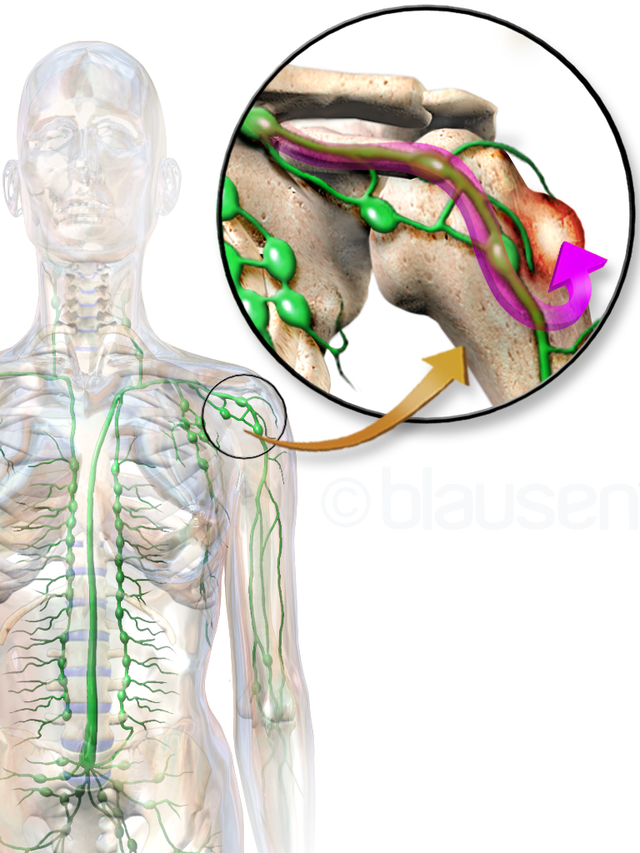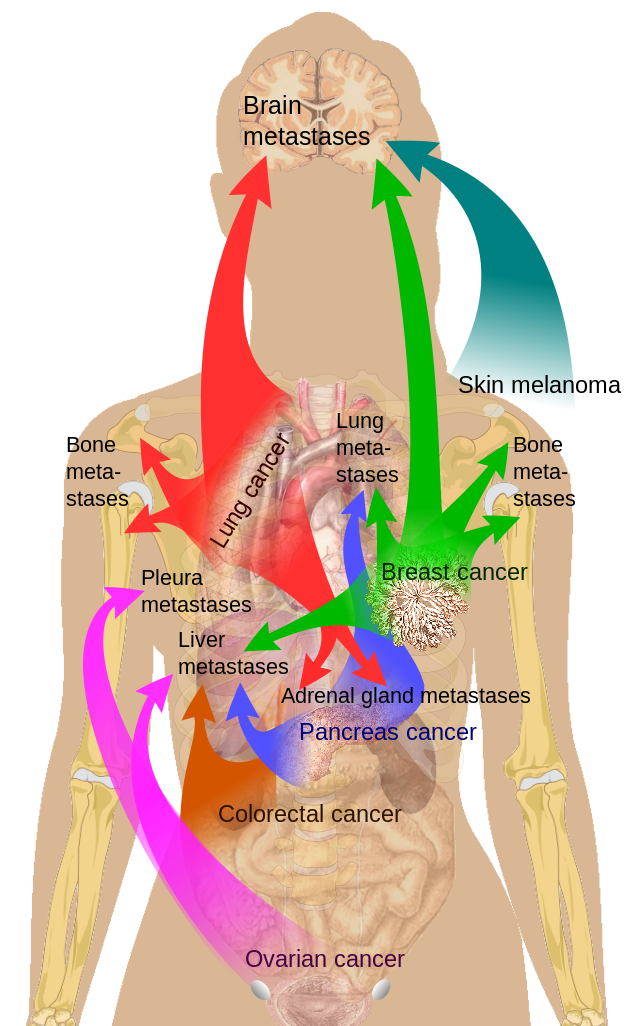Bone metastasis
|
WikiDoc Resources for Bone metastasis |
|
Articles |
|---|
|
Most recent articles on Bone metastasis Most cited articles on Bone metastasis |
|
Media |
|
Powerpoint slides on Bone metastasis |
|
Evidence Based Medicine |
|
Clinical Trials |
|
Ongoing Trials on Bone metastasis at Clinical Trials.gov Trial results on Bone metastasis Clinical Trials on Bone metastasis at Google
|
|
Guidelines / Policies / Govt |
|
US National Guidelines Clearinghouse on Bone metastasis NICE Guidance on Bone metastasis
|
|
Books |
|
News |
|
Commentary |
|
Definitions |
|
Patient Resources / Community |
|
Patient resources on Bone metastasis Discussion groups on Bone metastasis Patient Handouts on Bone metastasis Directions to Hospitals Treating Bone metastasis Risk calculators and risk factors for Bone metastasis
|
|
Healthcare Provider Resources |
|
Causes & Risk Factors for Bone metastasis |
|
Continuing Medical Education (CME) |
|
International |
|
|
|
Business |
|
Experimental / Informatics |
Editor-In-Chief: C. Michael Gibson, M.S., M.D. [1]
Overview
 |
 |
 |
Bone metastases, or metastatic bone disease, is a class of cancer metastases that results from primary tumor invasion to bone. Bone-originating cancers like osteosarcoma, chondrosarcoma, and Ewing's sarcoma are rare.[3] And, unlike hematological malignancies that originate in the blood and form non-solid tumors, bone metastases generally arise from epithelial tumors and form a solid mass inside the bone. Bone metastases cause severe pain, characterized by a dull, constant ache with periodic spikes of incident pain.[4]
Sources of bone metastases
Bone is one of the most common locations for metastasis.[5] While any type of cancer is capable of forming metastatic tumors within bone, the microenvironment of the marrow tends to favor particular types of cancer, including prostate, breast, and lung cancers.[1] Particularly in prostate cancer, bone metastases tend to be the only site of metastasis.[4]
Phenotypes
Under normal conditions, bone undergoes a continuous remodeling through osteoclast-mediated bone resorption and osteoblast-mediated bone deposition.[1] These processes are normally tightly regulated within bone to maintain bone structure and calcium homeostasis in the body. Disregulation of these processes by tumor cells leads to either osteoblastic or osteolytic phenotypes.[1] Regardless of the phenotype, though, bone metastases show osteoclast proliferation and hypertrophy.[6]
Symptoms
Bone metastases are a major clinical concern that can cause severe pain, bone fractures, spinal cord compression, hypercalcemia, anemia, spinal instability, decreased mobility, and rapid degradation in the quality of life for patients.[5][7] Patients have described the pain as a dull ache that grows worse over time, with intermittent periods of sharp, jagged pain.[4] Even under controlled pain management, these periods of breakthrough pain can occur rapidly, without warning, several times a day.[8]
- Effects of bone metastasis
- severe pain
- bone fractures
- spinal cord compression
- hypercalcemia
- anemia
- spinal instability
- decreased mobility
Causes of symptoms
- Acidosis
Acidosis is the increased acidity in a given location, whether it is blood, urine, or tissues. Osteoclasts generate extracellular protons, lowering the pH of the extracellular matrix (ECM) around the osteoclast to approximately 4.5.[9] Nociceptors in the bone trigger a pain response in the brain in response to this acidosis.[10] It is thought that this is the primary source of the dull, chronic pain experienced by patients with bone metastasis.[citation needed]
- Bone restructuring
The uncoupled regulation of the osteoclasts and osteoblasts leads to malformation of the bone.[4] Malformed bones are unable to withstand the normal mechanical stresses placed on them in day-to-day activity, leading to fractures, spinal compression, and spinal instability. Malformed bones may also mechanically trigger pain receptors both within the bone and in the surrounding tissue.
Treatment
The traditional treatments for cancer are Radiotherapy and chemotherapy, usually in combination with one another. Scientists and pharmaceutical companies are researching drugs to target different types of cancer, including metastatic bone disease.
High-intensity focused ultrasound (HIFU) has CE approval for palliative care for bone metastasis. As an entirely side-effect free and non-invasive treatment, HIFU has been successfully applied in the treatment of cancer to destroy tumours of the bone, brain, breast, liver, pancreas, rectum, kidney, testes, and prostate.[citation needed] HIFU treatments are still in investigatory phases as more information is needed to study effectiveness in order to obtain full approval in countries such as the USA. In China HIFU has CDFA approval since 2001 and over 180 treatment centres have been established in China, Hong Kong, and Korea. It is expected that HIFU may become one of the fastest, most effective, and safest methods to treat some cancers.[citation needed] No anesthetic is required. The focused hyperthermia response of body tissue to HIFU is easily guided using MRI to yield a very precise technique.
One treatment that has been considered is bisphosphonates. Bisphosphonates have shown great promise in reducing bone cancer pain, bone destruction, and tumor growth.[11] However, they have exhibited side effect such as the induction of arthralgias and osteonecrosis of the jaw.[12]
Monthly injections of radium-223 chloride (as Xofigo, formerly called Alpharadin) have been approved by the FDA in May 2013 for castration-resistant prostate cancer (CRPC) with bone metastases.
Pain management
The World Health Organization's pain ladder was designed for the management of cancer-associated pain, and mainly involves various strength of opioids.
Other treatments include bisphosphonates, corticosteroids, radiotherapy, and radionucleotides.[4] Percutaneous osteoplasty involves the use of bone cement to reduce pain and improve mobility.[13]
In palliative therapy, the main options are external radiation and radiopharmaceuticals.[14]
See also
References
- ↑ 1.0 1.1 1.2 1.3 Guise T (October 2010). "Examining the metastatic niche: targeting the microenvironment". Semin. Oncol. 37 (Suppl 2): S2–14. doi:10.1053/j.seminoncol.2010.10.007. PMID 21111245.
- ↑ List of included entries and references is found on main image page in Commons: Commons:File:Metastasis sites for common cancers.svg#Summary
- ↑ Template:MedlinePlusOverview
- ↑ 4.0 4.1 4.2 4.3 4.4 Jimenez-Andrade JM, Mantyh WG, Bloom AP, Ferng AS, Geffre CP, Mantyh PW (June 2010). "Bone cancer pain". Annals of the New York Academy of Sciences. 1198: 173–81. doi:10.1111/j.1749-6632.2009.05429.x. PMID 20536932.
- ↑ 5.0 5.1 Coleman RE (October 2006). "Clinical features of metastatic bone disease and risk of skeletal morbidity". Clin. Cancer Res. 12 (20 Pt 2): 6243s–9s. doi:10.1158/1078-0432.CCR-06-0931. PMID 17062708.
- ↑ Halvorson KG, Sevcik MA, Ghilardi JR, Rosol TJ, Mantyh PW (September 2006). "Similarities and differences in tumor growth, skeletal remodeling and pain in an osteolytic and osteoblastic model of bone cancer". Clin J Pain. 22 (7): 587–600. doi:10.1097/01.ajp.0000210902.67849.e6. PMID 16926574.
- ↑ Mercadante S (January 1997). "Malignant bone pain: pathophysiology and treatment". Pain. 69 (1–2): 1–18. doi:10.1016/S0304-3959(96)03267-8. PMID 9060007.
- ↑ Zeppetella G (March 2009). "Impact and management of breakthrough pain in cancer". Current Opinion in Supportive and Palliative Care. 3 (1): 1–6. doi:10.1097/SPC.0b013e3283260658. PMID 19365156.
- ↑ Teitelbaum SL (February 2007). "Osteoclasts: what do they do and how do they do it?". Am. J. Pathol. 170 (2): 427–35. doi:10.2353/ajpath.2007.060834. PMC 1851862. PMID 17255310.
- ↑ Julius D, Basbaum AI (September 2001). "Molecular mechanisms of nociception". Nature. 413 (6852): 203–10. doi:10.1038/35093019. PMID 11557989.
- ↑ Lipton A (2008). "Emerging role of bisphosphonates in the clinic—antitumor activity and prevention of metastasis to bone". Cancer Treat. Rev. 34 (Suppl 1): S25–30. doi:10.1016/j.ctrv.2008.03.008. PMID 18486347.
- ↑ Drake MT, Clarke BL, Khosla S (September 2008). "Bisphosphonates: mechanism of action and role in clinical practice". Mayo Clin. Proc. 83 (9): 1032–45. doi:10.4065/83.9.1032. PMC 2667901. PMID 18775204.
- ↑ Anselmetti, Giovanni Carlo (June 2010). "Osteoplasty: Percutaneous Bone Cement Injection beyond the Spine". US National Library of Medicine: National Institutes of Health. doi:10.1055/s-0030-1253518. Retrieved 11 October 2014.
- ↑ Criteria for Palliation of Bone Metastases – Clinical Applications from International Atomic Energy Agency. Retrieved November 2011
Further reading
- Bellahcène A, Castronovo V (January 1997). "Expression of bone matrix proteins in human breast cancer: potential roles in microcalcification formation and in the genesis of bone metastases". Bull Cancer. 84 (1): 17–24. PMID 9180854.
- Furger KA, Menon RK, Tuck AB, Bramwell VH, Chambers AF (November 2001). "The functional and clinical roles of osteopontin in cancer and metastasis". Curr. Mol. Med. 1 (5): 621–32. PMID 11899236.
- Ibrahim T, Leong I, Sanchez-Sweatman O; et al. (2000). "Expression of bone sialoprotein and osteopontin in breast cancer bone metastases". Clin. Exp. Metastasis. 18 (3): 253–60. PMID 11315099.
- Chung, Leland W.K.; Isaacs, William B.; Simons, Jonathan W. (2007). Prostate Cancer: Biology, Genetics, and the New Therapeutics. Humana Press. ISBN 978-1-59745-224-3.
- CS1 maint: Multiple names: authors list
- All articles with unsourced statements
- Articles with unsourced statements from November 2011
- Articles with invalid date parameter in template
- Articles with unsourced statements from January 2014
- CS1 maint: Explicit use of et al.
- Skeletal disorders
- Osseous and chondromatous neoplasia